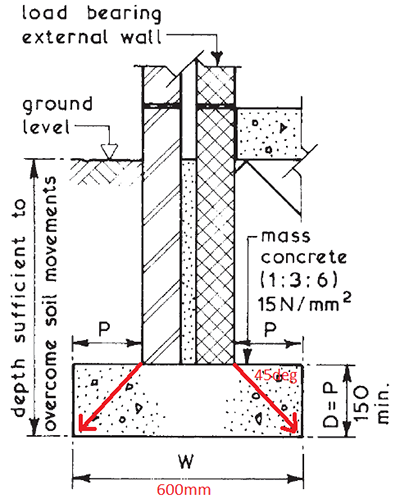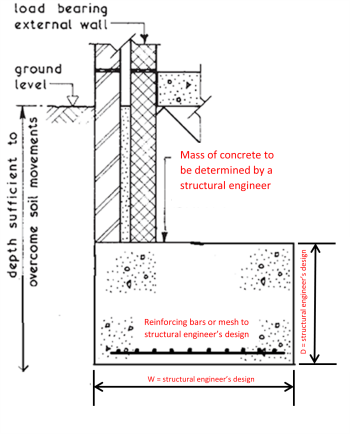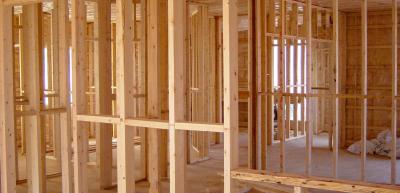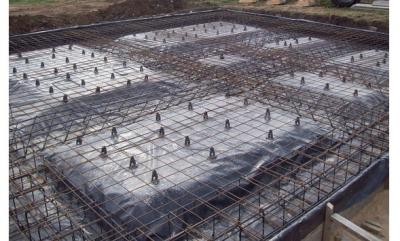Offset foundations: For when you're tight to the boundary
 The typical low rise domestic foundation detail to the left might be familiar to you. It's taken from the Building Construction Handbook 10th Edition, written by Roy Chudley & Roger Greeno.
The typical low rise domestic foundation detail to the left might be familiar to you. It's taken from the Building Construction Handbook 10th Edition, written by Roy Chudley & Roger Greeno.
First published in 1988 it's been one of the most popular reference books for anyone attending college and university construction courses.
It lays out quite clearly how foundations work where the load is applied centrally onto a minimum 150mm thick concrete strip foundation.
A 600mm wide foundation gives a 150mm projection either side of a 300mm wide wall (equal to the depth of concrete) and this allows the load to be distributed at 45 degrees across the entire width of the foundation into the supporting strata below.
But what can you do when you can't achieve the 600mm spread because you can't trespass across a boundary or if there is already another foundation next door?
In certain situations it may not be possible for the builder to construct a foundation with a typical projection as that shown above. In these circumstances an offset (or eccentric) foundation, which is an engineered type of foundation, could be considered (subject to design). The image below provides a typical example of how an offset foundation might be constructed.
The offset foundation
Care should be exercised when constructing foundations that are non-typical.
Even for some small and lightly loaded buildings, it’s not always possible to give definitive advice on the type of features that should be used, as other factors might need to be considered. Consequently, when constructing an engineered foundation, advice should always be obtained from a qualified and competent structural or civil engineer.
An engineer will be able to analyse the load on the foundation, the thickness and depth of the concrete, the mass of the concrete, and the type and position of any reinforcement in conjunction with the strength of the soil that the foundation will be placed upon.
If the site conditions are not suitable for either a traditional or offset foundation, you will need a structural engineer to design another foundation type such as a raft or piled foundation.
Read more about working with foundations
- Underpinning existing foundations
- How to get it right: Building a wall on foundations
- Foundations on clay soil
- Trees and foundations (foundation depth calculator)
- When and how to cut stepped foundations on a sloping site
Please Note: Every care was taken to ensure the information was correct at the time of publication. Any written guidance provided does not replace the user’s professional judgement. It is the responsibility of the dutyholder or person carrying out the work to ensure compliance with relevant building regulations or applicable technical standards.
This article was updated on August 2024
Sign up to the building bulletin newsletter
Over 48,000 construction professionals have already signed up for the LABC Building Bulletin.
Join them and receive useful tips, practical technical information and industry news by email once every 6 weeks.
Subscribe to the Building Bulletin





Comments
offset foundations
Submitted 5 years 11 months ago
does this mean that the 450 width can be measured from the external face of the wall?
Reply
Submitted 5 years 11 months ago
Thanks very much for your comment.
We've altered the wording of the article and hope that the information is now easier to follow!
Kind regards,
LABC
Single skin
Submitted 3 years 9 months ago
Thanks
LABC response
Submitted 3 years 9 months ago
Thank you for your enquiry. The building regulations for extensions to existing buildings or new buildings will consider cavity walls as the main form of construction. They also recognise that single skin walls may be used as internal loadbearing walls (as per diagram 9 in Approved Document A) or external walls to garages or outbuildings(with piers as in diagram 18 of Approved Document A). Therefore, in general terms the same principles apply to the width as in the article, i.e. that for loadbearing walls the wall is placed centrally on the foundation and then a spread (p) on either side (as shown in diagram 23 of Approved Document A). Therefore, for a single skin wall width of 100mm the foundation width the foundation width would be 100mm plus 150mm on either side, giving a minimum width of 400mm. This would increase with the thickness of the single skin accordingly.
You have also asked about the depth of the foundation and that is not a standard depth because the depth will entirely depend on the type of ground encountered. For example, if the ground is undisturbed natural ground, then in clay (with no trees within 30m) then the depth is likely to be at least between 0.75m for low shrinkage clay or at least 1.0m deep if highly shrinkable clay. If you encounter sands and gravels or chalk, then the minimum depth of at least 450mm is likely to be needed. If you need an inspection of the foundations for any controlled building work, then you should contact your LA team for advice on the specific depth.
Approved document A: https://www.labc.co.uk/professionals/building-regulations-guidance-documents/approved-documents-and-technical-guidance-england/approved-document-a-structure
Best,
LABC team
Foundation
Submitted 3 years 7 months ago
LABC response
Submitted 3 years 7 months ago
Thank you for your recent web enquiry. We recommend that this is something you should discuss with your structural engineer, and the local authority building control team who are likely to have local knowledge relating to the soil/ground conditions for the area and what the potential bearing pressures of the soil might be, which would dictate what width a traditional strip foundation might need to be.
Best,
LABC team
Building overhangs footings
Submitted 3 years 4 months ago
LABC Response
Submitted 3 years 4 months ago
“It is unusual for any part of a loadbearing wall to overhang the foundation, since the loads may not be being safely transmitted to the ground below.
However, if the masonry (brickwork) is a form of cladding that is fixed directly back to the structural wall (concrete filled polystyrene), which in turn affords all the support to the cladding and transmits all the loads through the concrete foundation to the ground below, then this might be acceptable if it has been properly designed to do this. Otherwise, the outside face of the brickwork to a cavity wall type building, should be such that the two leaves are suitably positioned on the concrete foundation. Whether the brickwork is close to the edge of the foundation or more central would have been a matter for the designer to specify. We recommend that you obtain independent advice from a qualified and competent construction professional such as a, Chartered structural engineer, Surveyor or Architect to inspect and advise you on the suitability of the foundation to the brickwork.”
Kind Regards,
LABC Team
Ring beam foundation.
Submitted 3 years 1 month ago
Originally we were having standard trench foundations with the block work offset and wondering if this can be transferred over.
LABC response
Submitted 3 years 1 month ago
Thank you for your comment. LABC is unable to comment on the details in regard to your foundation as we cannot give specific advice on projects that are in progress. Your LABC team where the work is based will be able to provide an answer to your question as part of your building regulation application.
Best,
LABC team
Add new comment